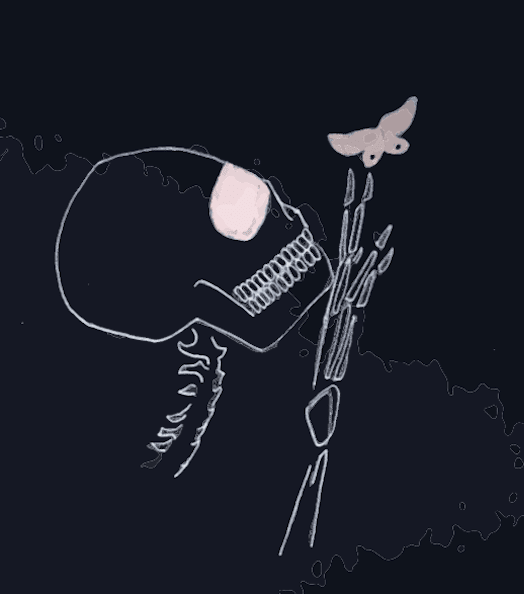FROM HERE TO ETERNITY:
Traveling the World to Find the Good Death
By Caitlin Doughty
Illustrated by Landis Blair. 248 pp. W.W. Norton & Company.
Book Review by Alexandria Kominsky | Drawings by Courtney W. Brothers
I n From Here to Eternity: Traveling the World to Find the Good Death, Caitlin Doughty tackles death positivity: the idea that cultures of silence and shame around death do more harm than good to society. As a practicing mortician, podcast host, entrepreneur and now author, Doughty has devoted over a decade to encouraging audiences to adopt healthier end-of-life attitudes. She founded The Order of the Good Death in 2011, a self-described “group of funeral industry professionals, academics, and artists exploring ways to prepare a death-phobic culture for inevitable mortality.”
Caitlin Doughty’s book is an anthropological expedition across the world, examining how different cultures treat their dead. She engages an otherwise serious, solemn subject with curiosity, awe, and humor. Observing unfamiliar funeral rites, Doughty offers new possibilities to reconcile with death. Death is hard to grapple with, and Western culture tends to value stoicism over mourning. With the goal of debunking stigmas towards death in her mind, Doughty sets sail around the globe on her search to "find the good death."
We learn about myriad practices to prepare bodies for their final rest—like mummification, cremation, embalming, and natural decomposition. In South Sulawesi, a remote region in Indonesia, mummification is common. Unearthing a corpse years after its burial might seem spine-chilling, but reading about a mother’s elation upon unwrapping her mummified son who died at sixteen compels us to recognize that our sources of joy are framed by cultural context.

Travelling next to Mexico, Doughty acquaints us with the traditional festival commemorating deceased friends and family, Día de los Muertos, or “The Day of the Dead.” The multi-day holiday featuring marigolds, skulls, and bright colors is held annually in November and gathers whole communities to grieve collectively. It is a celebration. “Each year,” Doughty writes, “The border between the living and the dead thins and frays, allowing the spirits to transgress.” Families leave offerings to symbolize a promise that they’ll be there, year after year. If they show up, so will the spirit.
In Spain, Snow White-esque corpses rest in glass box displays. In Bolivia, human skulls called ñatitas are thought to possess distinct personalities and powers to bless those that take care of them. In Japan, where almost all bodies are cremated, family members use chopsticks to transfer bones from ash into an urn. These customs give mourners a space for communal grieving.
Turning her attention to marine mammals, Doughty takes us to depths to investigate whale falls—the descent of whale carcasses to their final resting place on the ocean floor. Their remains in the bathyal (midnight) zone of the ocean offer fertile grounds for an ecosystem that benefits from the rich nutrients for decades. Forensic researchers at Western Carolina University are interested in whether human cadavers might supply a similar kind of sustenance. Planting bodies in mounds of earth—“turning corpses into compost”—is a process of transformation they’ve named recomposition.
Of course, the reader increasingly wonders how a death expert thinks about her own eventual death. Doughty is drawn to the Tibetan custom of sky burial. Practiced exclusively in the mountains of Tibet, sky burials are performed by a rogyapa who expertly slices a body’s skin and muscle and feeds it to Himalyan griffon vultures. “I spent the first thirty years of my life devouring animals,” Doughty observes. “So why, when I die, should they not have their turn with me? Am I not an animal?” I’m with her. Rather than rotting in an overpriced casket, I like the idea of returning to the natural world.
COVID-19 has taken millions of lives. Though death has not stopped for us—to adapt the famous Dickinson line—we may at least stop for it. From Here to Eternity is an opportunity to reflect on the ageless reality of loss. Hospitals, mortuaries, morgues, and funeral homes are overwhelmed with the dead. Nightmarish images of bodies rotated in refrigerators, kept in “mobile morgues,” or in cardboard caskets push us to reckon with the fact that our current system for handling the dead is, at minimum, ill-equipped. Amidst this scale of global loss, Doughty’s work provides meaningful alternatives to care for the dead.
To learn how cultures honor their dead is illuminating. It reminds us that the transition into whatever is next is important, as is celebrating life. From Here to Eternity: Traveling the World to Find the Good Death is an affirmation that death doesn’t signify the end of connection. ◘